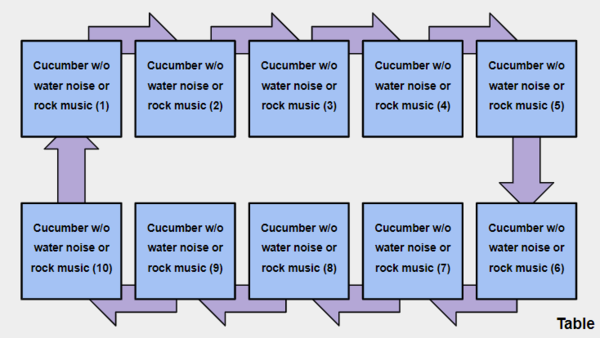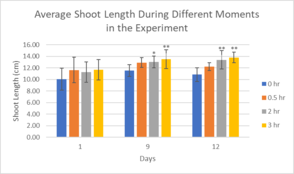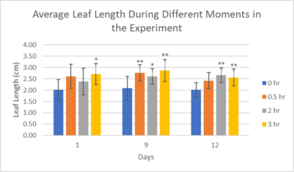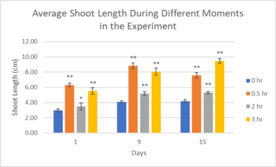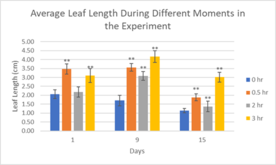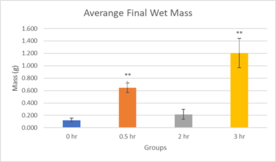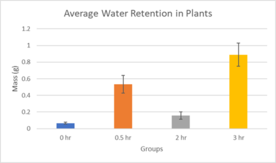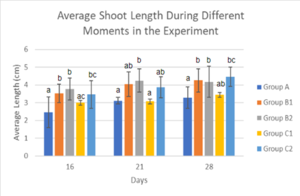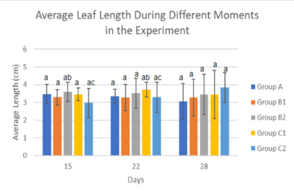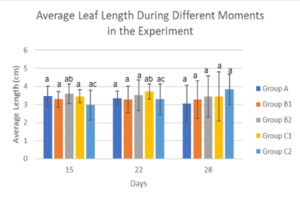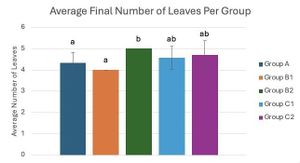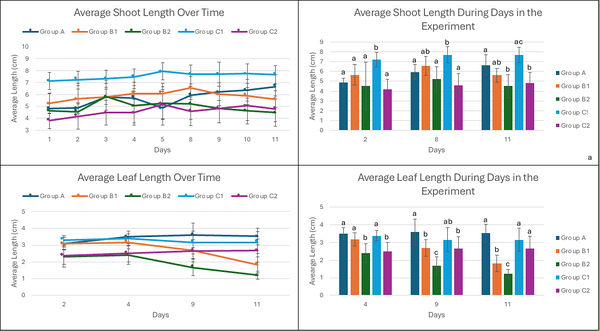Abstract – Previous studies show that plants can recognize and respond to different sounds, such as insect-chewing and running water. Prior research demonstrated that plants can learn and respond to stimuli like touch; it is unclear if plants can have a conditioned response to sound. Our former study found that plants can recognize the sound of stream water (SW) and continue growing throughout drought. Experimentation aimed to investigate if Cucumis sativus plants can grow throughout drought when conditioned to associate non-water sounds to the sound of water. The hypothesis was that cucumber plants would respond to sounds besides SW after auditory conditioning. Some groups were given a training phase (TP) to help them develop an association between their chosen sound and watering session, while others were not given a TP. After the TP was concluded, all groups went into drought stress, while still being exposed to sound. Control groups had no exposure to sound at all. Shoot lengths, leaf lengths, and chlorophyll contents were collected throughout and at the end of the experiment. Overall, groups with rock music (RM) and TP and the sound of water with or without TP had a visible increase in growth, while RM without TP had comparable results to control. Future research will determine if the ability of plants to respond to auditory conditioned learning is altered depending on the time of training relative to the stages of a plant’s life cycle, similarly to a person’s capability to learn and develop at different stages of life.
Keywords: Auditory, conditioned, learning, recognition, association
Introduction
Numerous previous studies tested the effects of different sounds on plants. These studies found that, despite not yet understanding the mechanism plants use, plants are able to recognize different sounds and respond to them physiologically. Continuing, one previous study found that when plants are pre-treated with the sound of insect chewing and then later fed to caterpillars, they had increased levels of anthocyanin and glucosinolate (which are chemical defenses), showing how plants can recognize specific sounds and respond to them accordingly to help improve their survival rates in response to stress1.Finally, one study done by Gagliano found that plants were able to recognize the sound of water and grow their roots toward the sound to improve their water levels2. These previous studies show how plants recognize different sounds based on their frequency (hertz, or Hz) and the type of sound, having physiological changes accordingly.
Previous Research
Plants limit their growth under poor watering conditions to improve survival rates, even under sufficient watering conditions. Previously, our research concluded that Cucumis sativus plants can respond to the sound of stream water under drought stress, not limiting their growth, as well as showing significantly delayed signs of drought. We observed the plants with a longer period exposed to the sound of stream water, such as 3 hours, had a significant overall growth compared to the groups with a shorter period of exposure and no exposure. Additionally, our third trial found that the plants, without a training period (unlike in the first two trials), had severely mitigated results, with growth very similar to the control3. Furthermore, previous research found that plants can be conditioned to have a certain physiological response (like growing in a certain direction) in response to different stimuli, like touch4. These past findings suggest that not only can plants learn through conditioning, but that they can do so as well using sound5-8.
Another previous study done by Gagliano found that plants are capable of associative learning. Using a two-pronged maze on top of each plant, they tested the negative and positive conditioning of a fan. This consisted of one group having the fan and light on the same side (positive conditioning, associating the fan with the light) and another group with the fan and light on the opposite sides (negative conditioning, associating the fan with no light). After 3 days of this training, they then set the plants up with just the fan and the absence of light and found that a majority of the plants grew where they were conditioned to associate the fan with based on if they receive positive or negative conditioning training4. Overall, this study confirmed that plants are conditioned to have a certain response, with a high majority showing learning. One important gap in conditioning research is if plants can have a conditioned response using sound alone, rather than touch (like the wind from the fan), as well as a response exhibited in factors outside of the direction of growth alone, like stress levels. This experiment tests two different sounds, the sound of stream water and the sound of rock music to determine if plants can be conditioned to react to other sounds as they would to the sound of water.
Kirby Cucumber
Kirby Cucumbers, (or Cucumis sativus. L.), also known as pickling cucumbers, are a part of the Cucurbitaceae family and are a very important part of cuisine because of their prevalence in pickling and food. In addition, they are known for their thin, bumpy skin and are easy to digest by animals9. They also require a large amount of water to maintain proper soil moisture to grow since they are very sensitive to drought stress10,11. Due to these factors, Kirby Cucumbers were chosen as an ideal candidate for testing the effects of the sound of stream water during drought conditions, in order to observe the possible positive effects it would have on the plant's overall plant growth.
Sound of Stream Water and Rock Music
The sound of water is heavily prevalent throughout nature and is critical for growth and survival in plants. The lack of water (or drought) is heavily apparent across the world, with water in some countries accounting for more than 50% of economic losses12. Many plants have adapted over time to increase their survival, such as the recognition of water according to studies2,4. Not much is known about the dynamics between plant’s recognition of sounds (such as water) and how plants can perform this, but these studies show that plants can show recognition in various ways, like through improved growth, growing towards the source of the sound of water, or even locating underground water sources with high accuracy. While these dynamics with sound recognition and plants have not been extensively studied, many previous studies document the effects of various sounds on plants13,14.
There are connections made between why certain sounds improve or mitigate plant growth, with theories about certain frequencies, certain volumes, etc. Throughout these studies, locating a sound that shows very little positive or negative effect on its own for plant growth that can be used as a neutral sound for the purposes of this experiment led to the selection of rock music, as it has shown to have very little positive or negative correlation to plant growth. Rock music was an ideal candidate as it was previously tested in research confirming its neutral or somewhat negative effects14,15, and has no possible connections to any natural sounds that plants might have also developed recognitory abilities for (such as insect chewing1 or bird chirping), allowing this sound to not have any possible improvements in growth for any confounding reasons. Rock music is also an artificially made and highly contemporary sound, ensuring that it could not have any bias in terms of recognition, for example, vedic chants and classical music have positive effects on plants despite also being music and artificially made14.
Purpose and Hypothesis
The purpose of this experiment was to see if the hearing capabilities of plants for certain sounds is an inherent capability or developed through experience. It was hypothesized that the Cucumis sativus's capability to recognize the sound of rock music is developed through experience and training, like conditioned response, although there is not much previous research available supporting any theories on this specific matter. If the plant experiences improved growth and decreased stress levels mirroring the sound of water treatment on Cucumis sativus plants under drought stress, then the plants are capable of auditory conditioned learning.
Materials and Methods
Experimental Preparation
First, 50 Cucumis sativus L. seeds, 50 acrylic pots (9 cm x 9 cm x 9 cm), 5,750 g of soil (115 g for each pot), 1 laptop, 1 speaker, and 50 squares of fabric (9 cm x 9 cm) were obtained. A calm stream water recording (https://www.youtube.com/watch?v=UJZxtO9XNno) and a rock music recording (https://www.youtube.com/watch?v=bNcwrLVA4pY&ab_channel) was played on a speaker connected to the laptop, set at an average volume of 72.5 dB and frequency ranging from 500-900 Hz and 2,000-2,700 Hz respectively.
Table 1: plant growth in drought with/without the sound of water, and the sound of rock music.
| Groups | Presence of the sounds | Periods of sounds (hrs) each session, 4 times a week | Distance from speaker device (cm) | Amount of times watered per week during beginning phase (1 week) | Amount of times watered per week during drought phase (3 weeks) | Amount of water each time (mL) | Label |
| Group A (control group) | None | 0 | N/A | 4 | 2 | 15 | HMG-A-1-10 |
| Group B1
(sound of stream water) |
Starting after germination (no training phase) | 3 | 16 | 4 | 2 | 15 | HMG-B1-1-10 |
| Group B2
(sound of stream water) |
Before and after germination
(with training phase) |
3 | 16 | 4 | 2 | 15 | HMG-B2-1-10 |
| Group C1
(sound of rock music) |
Starting after germination (no training phase) | 3 | 16 | 4 | 2 | 15 | HMG-C1-1-10 |
| Group C2
(sound of rock music) |
Before and after germination
(with training phase) |
3 | 16 | 4 | 2 | 15 | HMG-C2-1-10 |
Growth of Cucumis sativus
10 pots each were placed onto 5 trays (separated by group) and using a ruler, the index finger of a glove was marked off at 2 cm depth. Wearing this glove, 2 cm holes were made in the middle of each pot of soil, and seeds were sowed in each pot. The hole was then covered with 115g of soil, and this process was repeated for all pots. Each pot was labeled according to Table 1. The seeds were planted and watered with 15mL 4 days a week until they were germinated, (which was determined to be the presence of a shoot above the soil) while being treated with the sound of water or rock music for 3 hours (except for group A, B1, and C2). Plants were then watered a total of 4 days a week, coinciding with the sound of water or rock music 4 days a week. Once the seeds were germinated, drought treatment began a week after (end of the training phase) the day the sound of water started.
Each group was watered with 15 mL of water 2 days a week. Outside of the training phase, same-lettered groups were now treated the same: the sound of stream water was played for groups B1 and B2 for 3 hours while the sound of rock music was played for groups C1 and C2 for 3 hours, and all groups were watered within this time. Group A (the control group) had no exposure to the sound of stream water or rock music during any portion of the experiment. The speaker was approximately 16 cm away from all groups, and when a group reached their required time of treatment, they were moved into the lab room with the control group to ensure that no sound could be intercepted until it was time for their sound treatment again. The plants were rotated every day to ensure all plants received the same amount of sunlight, which will follow in Figure 1. There were 10 plants at each table (with one group at each table).
Figure 1: Plant rotation for each group, all groups followed this same pattern; by S. Huang.
Measurement
Several variables were measured throughout all trials. Firstly, the shoot length was recorded. This was done by measuring the length of all 50 plants (10 in each group). The length was considered as the distance from the bottom of the shoot outside of the soil to the highest point of the shoot. Additionally, the leaf length was collected. All 50 plants’ leaves were measured. Leaf length was considered as the distance from the tip of the leaf to the base of the leaf connected to the stem. Only leaves that were above 2 cm were considered to not drag down data due to measuring newly formed leaves. Furthermore, photos were taken weekly of each group for qualitative observations. Continuing, the number of leaves was observed. This was done by counting the number of leaves of all plants, including newly formed leaves. Furthermore, the average root length was measured at the end of the experiment. This was done by removing the plants from the pots and removing any attached soil from the roots, then adjusting the roots to be straight and using a ruler to precisely measure the length in centimeters. The data was then averaged by each group to obtain a mean value for each group. Lastly, dry/wet mass as well as water retention and chlorophyll content were measured. At the end of the experiment, the plants were removed from the soil using hands and then washed and weighed on a precise scale, which was recorded for wet mass. Then the plants were heated at 42o C overnight until all water was removed and re-measured. This new value is subtracted from the original value to calculate the final dry mass. The values for wet and dry mass were subtracted from each other to determine the plant water retention for each group. Using the spectrometer, chlorophyll and chlorophyll B amounts were measured. All data was collected 4 days a week (except for root length, wet/dry mass, and plant water retention), excluding a few days where data could not be collected (like for example weekends or holidays).
Data Analysis Plan
Data was stored in an Excel spreadsheet. The data collected displayed comparisons. The average shoot length was calculated by finding the average length per plant in each group for each day measured. The average leaf width was performed in a similar manner, but instead calculating the average per leaf rather than per plant. The average number of leaves, dry mass, wet mass, and water retention was determined through the average per plant in each group. Firstly, bar diagrams were used, which compared the average amount of leaves by the end of the experiment between groups, which was calculated at the end of the experiment, as well as the average shoot and leaf length at key moments during the experiment to better illustrate comparisons of significance over time. In addition, line graphs were used to compare average shoot length growth and average leaf length growth between groups over time. Finally, bar graphs were used to compare the average final dry, wet mass, chlorophyll content as well as average water retention of the plants among groups. Finally, the significant analysis was calculated using ANOVA alongside Tukey HSD, which was denoted within figures with the use of asterisks to signify different levels of significance. Standard deviations, means, and ratios were calculated using standard functions within excel, while ANOVA with Tukey HSD was calculated using a separate website (https://astatsa.com/OneWay_Anova_with_TukeyHSD/).
Results
{| |- | 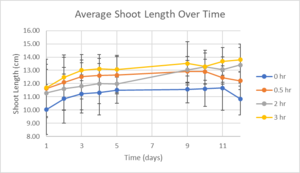 | |}
| |}
{| |- | 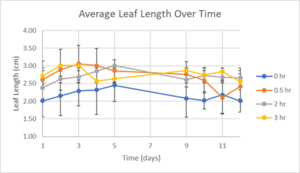 | |}
| |}
Figure 2: The Average Shoot Length and Leaf Length Over Time for Trial 1.
Figure 2. Average shoot length and leaf length over time-Trial 1. Each line or bar represents a different amount of treatment of the sound of stream water. There were 10 plants per group. Error bars represent the standard deviation. Generally, increased treatment lead to increased growth, even through the later phases of drought stress where withering occurs. ANOVA followed by Tukey HSD was conducted to determine the significant difference *p<0.05, **p<0.01 compared with the control group.
{| |- | 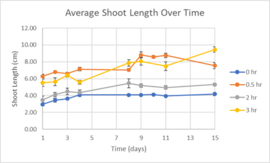 | |}
| |}
{| |- | 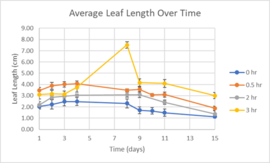 | |}
| |}
Figure 3: The Average Shoot Length and Leaf Length Over Time for Trial 2.
Figure 2. Average shoot length and leaf length over time-Trial 2. Each line or bar represents a different amount of treatment of the sound of stream water. There were 10 plants per group. Error bars represent the standard deviation. Generally, increased treatment lead to increased growth (except in the case of the 2 hr group), even through the later phases of drought stress where withering occurs. ANOVA followed by Tukey HSD was conducted to determine the significant difference *p<0.05, **p<0.01 compared with the control group.
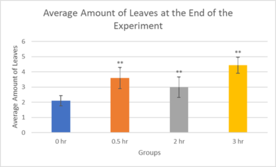
|
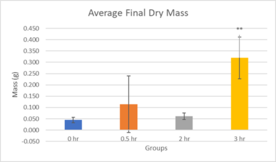
|
Figure 4: The Average Amount of Leaves, Final Wet Mass, Final Dry Mass, and Average Water Retention at the End of Trial 2.
Figure 4. Comparison of final plant conditions among groups-Trial 2. Each line or bar represents a different amount of treatment of the sound of stream water. There were 10 plants per group. Error bars represent the standard deviation. Generally, increased treatment lead to increased growth (except in the case of the 2 hr group), even through the later phases of drought stress where withering occurs. ANOVA followed by Tukey HSD was conducted to determine the significant difference *p<0.05, **p<0.01 compared with the control group.
{| |- | 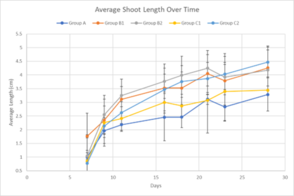 | |}
| |}
{| |- | 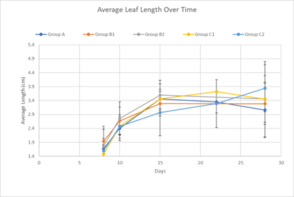 | |}
| |}
Figure 5: The Shoot Length and Leaf Length Over Time for Trial 3.
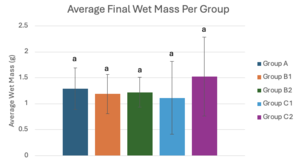
|
Figure 5: Groups with “2” had a training phase, while groups with “1” did not. 10 plants were used in each group for this trial. Error bars represent the standard deviation. The “2” groups show an increase in height when compared to their “1” counterparts and Group A (control). ANOVA followed by Tukey HSD was conducted to determine the significant difference, represented with different lettering.
Figure 6: The Average Amount of Leaves, Final Wet Mass, and Final Dry Mass at the End of Trial 3.
Groups with “2” had a training phase, while groups with “1” did not. 10 plants were used in each group for this trial. Error bars represent the standard deviation. C groups showed no significance in the average final number of leaves while group B2 showed significance between B1 and control group. All groups showed no significance between each other when comparing the average final day and wet mass. ANOVA followed by Tukey HSD was conducted to determine the significant difference, represented with different lettering.
Figure 7: The Average Shoot Length and Leaf Length Over Time for Trial 4.
Groups with “2” had a training phase, while groups with “1” did not. 10 plants were used in each group for this trial. Error bars represent the standard deviation. The “1” groups and group A (control) show an increase in height when compared to their “2” counterparts. ANOVA followed by Tukey HSD was conducted to determine the significant difference, represented with different lettering.
Figures 2-4 demonstrate that the control group had significantly lower average shoot and leaf length compared to 0.5-, 2-, and 3-hour treatments, implying that the exposure to the sound of stream water improved growth, compared to without it. Additionally, the group with the most amount of treatment (3 hour) exhibited the most overall growth compared to all other control and experimental groups, showing that extended exposure further improves growth, compared to little exposure. It was also shown that group 3 had the highest overall wet and dry mass in comparison to the rest of the groups. Some observations made throughout the experiment were that group 1 and 2 had a slow germination rate and the plants in group 3 and 4 grew at an increasing rate. Group 1 showed signs of wilting at an early stage of growth while groups 2, 3, and 4 all had strong stems that held the plants up. Figures 5 demonstrate that rock music with training (C2) was comparable to water sounds with or without training (B1 and B2, respectively), while rock music without training (C1) was comparable to control (A). Figure 6 shows that there is no significant difference in wet mass and dry mass between all groups. The only difference for the final number of leaves is increased growth in group B2 when compared to group A or group B1. Figure 7 demonstrates that average shoot length and average leaf length of “1” groups is overall higher than “2” groups, of which stays significant in the shoot length but not in the leaf length.
Discussion and Conclusion
The hypothesis created for trials 1 and 2 were that cucumber plants treated with the sound of stream water would exhibit signs of improved shoot length, leaf width and amount, as well as dry and wet mass. Based on the data that was collected throughout 2 trials, the sound of stream water had beneficial effects on growth, of which was (in general) magnified by greater amounts of exposure. The sound of stream water improved shoot length at all tested exposures (0.5, 2, and 3 hours) (Figs 2 and 3), which supports the findings from past studies that concluded that the sound of water improved the growth of plants though not under drought stress14. For the shoot growth shown in the first trial, the experimental groups all had significantly more growth compared to control, with the 3 hour treatment having the most and the 2 hour group having less than the 0.5 hour group in the early stages of the experiment while in trial 2 such significant results were only exhibited in 0.5 and 3 hour treatments, with 0.5 hour treatment having significantly better results than 3 hour treatment, and the group exposed with 2 hour treatment only having a slight improvement (1.1 cm) compared to control at the end of the experiment, overall implying that any level of exposure to treatment, even with differing circumstances, can significantly improve shoot growth.
The average leaf width in Trial 1 followed similar patterns to the shoot growth, with all experimental groups having significantly improved leaf width, this time with the group exposed to 2 hour treatment having the most improvement compared to control, despite the fact that the 3 hour treatment group was leading for the majority of the experiment (Fig 2), while again for Trial 2 the 3 hour group had massively improved growth, and the 2 hour group was only slightly better than control and worse than the 0.5 hour group (Fig 3) Additionally, throughout all trials signs of withering leaves were only exhibited near the end of the experiment in the experimental groups, while in the control groups signs of withering were observed early within the commencement of drought stress, implying that the sound of stream water treatment also delayed the effects of withering.
When looking at the average amount of leaves each plant had, the 3-hour group had over double the average amount of leaves in the control group, while the 2- and 0.5-hour groups had similar amounts of leaves (Fig 4). Overall, the results shown through Trial 2 imply that the sound of stream water can also further accelerate the growth of cucumber plants, allowing them to grow significantly more leaves on average compared to groups without sound treatment. In addition to growth measurements, average final wet and dry mass was also recorded. In Trial 2, the 3-hour group had very significantly more mass in both wet and dry forms compared to all other groups, and while the 2-hour group only showed a slight increase in wet and dry mass compared to control, the 0.5 hour0.5-hour group also had significantly more wet and dry mass when compared to control. This is further supported by the water retention calculations, with identical trends as average final wet and dry mass (Fig 4).
The hypothesis created for trial 3 was that rock music would follow identical trends to water sounds, or the belief that recognition of sound is solely dependent on experience rather than inherent recognition of certain sounds waves as a certain event (in this case, watering). However, based on the data collected from trial 3, it suggests that plants can use a combination of both inherent knowledge and experience when recognizing sounds, shown through how rock music with training was extremely similar to water with or without training, while rock music without training was extremely similar to control. As rock music has only shown negative or neutral effects on plant growth14, this increase in growth can be attributed to a correlation association to the sound of water, which would explain the increase in growth compared to control despite drought.
For the leaf length, every group was largely similar, especially near the end of the experiment (Fig 5). While there are no significant differences, there is still an observed increase in average leaf length in the C2 group from every other group at day 28, while at day 15, it was less than every other group (Fig 5). This might suggest that, as rock music could have negative effects on growth14, an increased exposure to it through a training period would lead to less growth. However, over time, the negative effects originating from rock music exposure lessened as the effects of drought stress got worse over time, resulting in the recognitory effects of rock music as the sound of water having a stronger impact then the negative effects of the rock music sound waves themselves.
The experiment had a few sources of error. There were a few days when the experimenters were unable to rotate or measure the plants to ensure proper sunlight distribution between the cucumber plants of all groups. In such cases, some plants might have had a more favorable position to grow in compared to others as they received slightly more sunlight. Constant visits would be performed for future trials to rotate and measure all plants on time. Another error was that some plants could not be counted towards the data collected due to errors that occurred during the setup of the experiment, causing lowered sample sizes for some groups. For the rest of the groups, the data also only had 10 seeds in each group per trial, causing our data to be susceptible to errors. To discourage this from happening again, all future trials should include larger sample sizes to get more reliable results and data. Furthermore, it was unfeasible to indicate the individual dry masses of each plant due to the small magnitude of its mass. Finally, Trial 4 had a systematic issue with the experimental conditions used for sound treatment. This caused an excess in interfering sounds during treatments, causing sound to have negative effects on growth, although patterns are still able to be reliably discerned from the data.
In the future, this experiment could be altered to determine the extent of sound recognition in plants. This would consist of determining the effect of other natural sounds that naturally affect plants on plant growth and stress levels, like the sound of thunder to see if the plants prepare to receive as much water as possible or for more vulnerable plants to try to protect themselves from heavy rain. Additionally, this experiment could be altered to see if plants could be able to correlate any sound (naturally or not naturally heard by plants) to an incoming stress and prepare, like thunder. In addition, these experiments could be performed on other plants not belonging to the Cucurbitaceae family to provide more authentic and widespread conclusions about the effects of the sound of stream water on plants under drought stress. Finally, these experiments could be observed across a longer period of time, and test the long-term effects of sound exposure on plants.
Acknowledgements
Thank you to Dr. D. Marmor, Mrs. N. Jaipershad, Dr. L. Wang, Ms. Zhu, Ms. Khemlani, Dr. J. Cohen, Dr. S. Lin, Mr. Z. Liang, Ms. DePietro, and the FLHS Science Department for funding.
References
[1] Appel HM, Cocroft RB. Plants Respond to Leaf Vibrations Caused by Insect Herbivore Chewing. Oecologia. 2014;175(4):1257-1266. doi:10.1007/s00442-014-2995-6
[2] Gagliano M, Grimonprez M, Depczynski M, Renton M. Tuned in: plant roots use sound to locate water. Oecologia. 2017;184(1):151-160. doi:10.1007/s00442-017-3862-z.
[3] M. Melika, S. Huang, T. Boumakis, J. Zhu and L. Wang, How Does the Sound of Stream Water Affect the Growth of Cucumis sativus Plants Under Drought?, J. of Dawn. R. (2024). Vol. 6, 3 URL https://www.scipedia.com/public/Melika_et_al_2023a
[4] Gagliano M, Vyazovskiy VV, Borbély AA, Grimonprez M, Depczynski M. Learning by association in plants. Scientific Reports. 2016;6(1). doi:10.1038/srep38427
[5] Shivanna KR. Phytoacoustics - Plants can perceive ambient sound and respond. Journal of the Indian Botanical Society. 2022;102(1):1-5. doi:10.5958/2455-7218.2022.00008.0
[6] Mishra RC, Bae H. Plant cognition: ability to perceive ‘Touch’ and ‘Sound.’ In: Springer eBooks. ; 2019:137-162. doi:10.1007/978-981-13-8922-1_6
[7] López-Ribera I, Vicient CM. Drought tolerance induced by sound in Arabidopsis plants. Plant Signaling & Behavior. 2017;12(10):e1368938. doi:10.1080/15592324.2017.1368938
[8] Del Stabile F, Marsili V, Forti L, Arru L. Is there a role for sound in plants? Plants. 2022;11(18):2391. doi:10.3390/plants11182391
[9] Passarella E. Cucumber primer: Kirby, Gherkin, English, and more… Kitchn. Published July 24, 2022. https://www.thekitchn.com/cucumber-primer-kirby-gherkin-58507
[10] Liu ZJ, Zhang X, Bai J, Suo BX, Xu P, Wang L. Exogenous paraquat changes antioxidant enzyme activities and lipid peroxidation in drought-stressed cucumber leaves. Scientia Horticulturae. 2009;121(2):138-143. doi:10.1016/j.scienta.2009.01.032
[11] ChunJuan W, Yang W, Wang C, et al. Induction of drought tolerance in cucumber plants by a consortium of three plant Growth-Promoting rhizobacterium strains. PloS One. 2012;7(12):e52565. doi:10.1371/journal.pone.0052565
[12] Ciasca BS, Klemz C, Raepple J, et al. Economic cost of drought and potential benefits of investing in Nature-Based solutions: a case study in São Paulo, Brazil. Water. 2023;15(3):466. doi:10.3390/w15030466
[13] Lai YN, Wu HC. Effects of different types of music on the germination and seedling growth of alfalfa and lettuce plants. Agrivita. 2020;42(2). doi:10.17503/agrivita.v0i0.2613
[14] Chivukula V, Ramaswamy S. Effect of different types of music on Rosa chinensis plants. International Journal of Environmental Sciences and Development/International Journal of Environmental Science and Development. 2014;5(5):431-434. doi:10.7763/ijesd.2014.v5.522
[15] Wang S, Shao Y, Duan J, He H, Xiao Q. Effects of Sound Wave and Water Management on Growth and Cd Accumulation by Water Spinach (Ipomoea aquatica Forsk.). Agronomy. 2022;12(10):2257. doi:10.3390/agronomy12102257
Document information
Published on 17/05/24
Submitted on 17/04/24
Volume 6, 2024
Licence: CC BY-NC-SA license
Share this document
Keywords
claim authorship
Are you one of the authors of this document?
